
La Earhcache / The Earhcache
► Contexte géologique global
La plage de Porz-Liogan au sud du Conquet est un endroit privilégié pour découvrir plusieurs formations métamorphiques qui ont façonné la région.
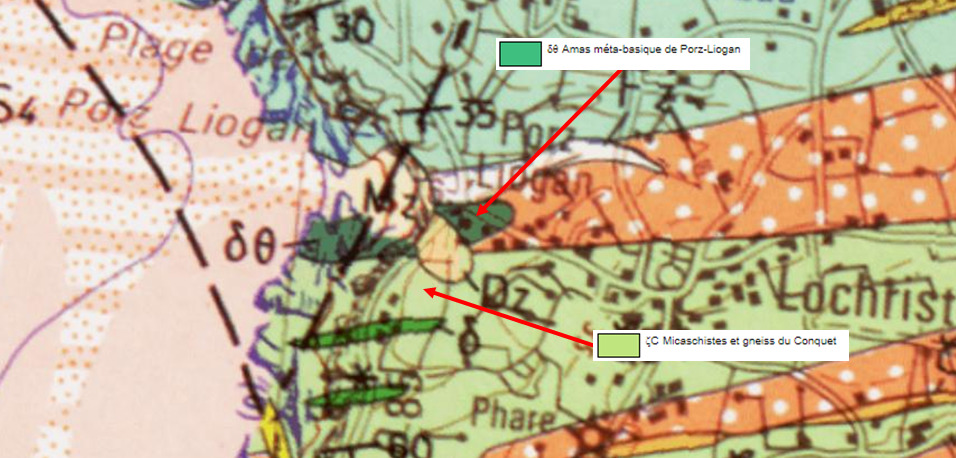
Partons sur les traces de ces ensembles géologiques venant d'une histoire mouvementée s'étant déroulée il y a 400 millions d'années.
► Porz-Liogan, une histoire géologique mouvementée
A partir du Dévonien (-390 Ma), le rapprochement du Gondwana et de l’Euramerica a fait que l’Armorique s’est retrouvée « enfermée » entre ces deux supercontinents.
Elle a été littéralement cisaillée avec la formation des failles CSA (Cisaillement Sud Armorique) et CNA (Cisaillement Nord Armorique) ; c'est le début de l'orogenèse hercynienne.
Cette collision a provoqué :
- Une augmentation de la pression et de la température entraînant une transformation des roches existantes selon le processus de métamorphisation.
- Des contraintes entraînant plissements et cisaillements des roches existantes.
► Les formations métamorphiques de Porz-Liogan
Le métamorphisme est l'ensemble des transformations minéralogiques, structurales et chimiques d'une roche appelée protolithe qui s’effectuent à l'état solide du fait d'une modification des conditions de température et/ou de pression dans un régime de contraintes.
Trois formations métamorphismes se sont mises en place à Porz-Liogan.

~ Le micaschiste à grenat
Les micaschistes sont des roches métamorphiques communes à grains fins (quasi invisibles à l'oeil nu) et à la schistosité marquée.
Ils présentent des lamelles brillantes, claires ou sombres selon la couleur du mica.
Dans le cas de Porz-Liogan, les protolithes sont des sédiments argileux (ou pélites), on parle donc de méta-pélites.
Les minéraux constitutifs sont des micas très abondants (biotite et/ou muscovite) et du quartz en cristaux dispersés. Les feldspaths sont en revanche peu fréquents, à la différence du gneiss.
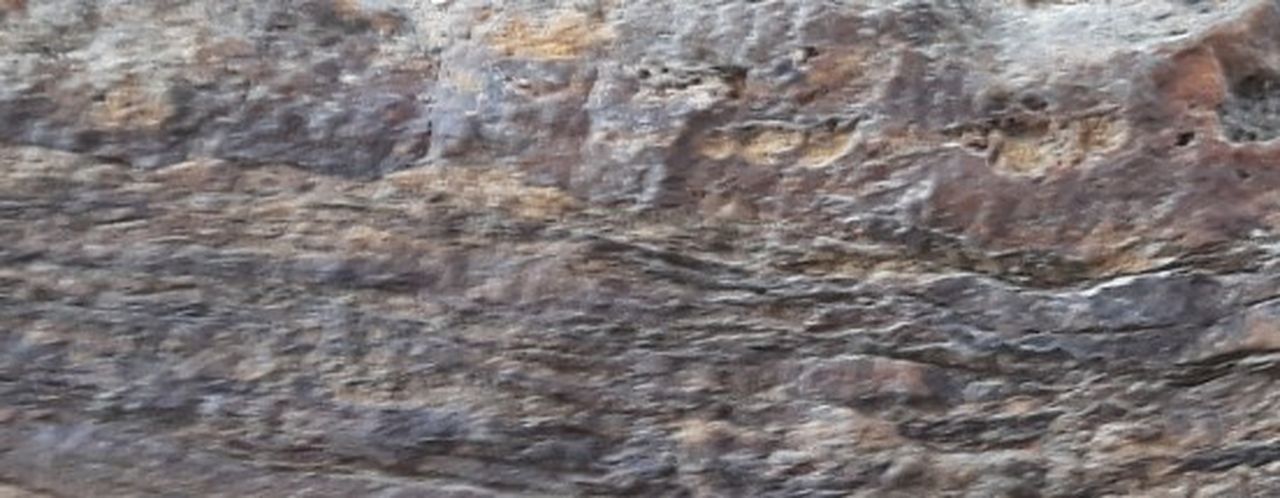
Ce micaschiste se caractérise par des minéraux accessoires, grenats de grande taille et staurodite.
Ces minéraux sont apparus pendant une seconde phase métamorphique il y a 338 Ma.

~ La Leptynite (gneiss du Conquet)
La Leptynite du Conquet est un paragneiss issu de formations sédimentaires.
Ici, le protolithe est un dépôt volcano-sédimentaire acide rhyolitique intégré dans les micaschistes.
Cette leptynite est donc une méta-rhyolite.
La formation est disposée en couches fines claires riches en petits yeux et filons de quartzite rose.
Ces couches de gneiss présentent de nombreux cisaillements ductiles verticaux qui ont découpé la roche avec des failles bien visibles avec rejet.
Un rejet de faille est la distance de déplacement d'un compartiment par rapport à l'autre.
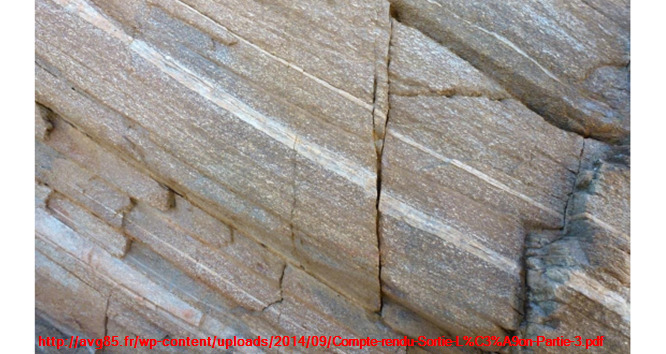
~ L'amphibolite métabasique
L'amphibolite est issue de la métamorphisation d’anciens gabbros basiques issus de la cristallisation d’un magma basaltique dans une chambre magmatique à l'Ordovicien (-478 Ma).
Ce sont donc des méta-gabbros
Elle contient des amphiboles sombres ferromagnésiennes et des feldspaths plagioclases blancs, opaques et brillants.
La roche est très peu litée et à texture grenue à la différence du micaschiste et du gneiss.
L'amphibolite est généralement une roche assez sombre, mais celle de Porz Liogan se distingue par sa teinte relativement claire du fait d'une proposition importante en plagioclases.
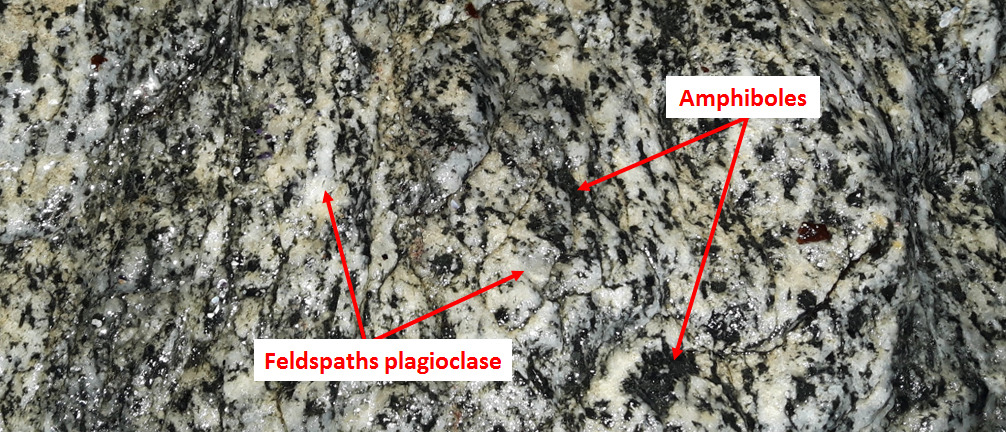
► Global geological context
The beach of Porz-Liogan in the south of Le Conquet is a privileged place to discover several metamorphic formations which have shaped the region.
Let’s follow in the footsteps of these geological ensembles from an eventful history that unfolded 400 million years ago.
► Porz-Liogan, a turbulent geological history
From the Devonian (-390 Ma), the merger of Gondwana and Euramerica meant that Armorica found itself "trapped" between these two supercontinents.
It was literally sheared with the formation of the CSA (Cisaillement Sud Armorique) and CNA (Cisaillement Nord Armorique) faults; it is the beginning of the hercynian orogeny.
This collision caused:
- An increase in pressure and temperature resulting in a transformation of existing rocks according to the metamorphization process.
- Constraints resulting in folding and shearing of existing rocks.
► Porz-Liogan metamorphic formations
Metamorphism is the set of mineralogical, structural and chemical transformations of a rock called a protolith that takes place in the solid state due to a change in temperature and / or pressure conditions in a stress regime.
Three metamorphism formations have taken place at Porz-Liogan.
~ The garnet mica schist
The mica schists are common metamorphic rocks with fine grains (almost invisible to the naked eye) and with marked schistosity.
They have shiny, light or dark lamellae depending on the color of the mica.
In the case of Porz-Liogan, the protoliths are clayey sediments (or pelites), we therefore speak of meta-pelites.
The constituent minerals are very abundant micas (biotite and / or muscovite) and quartz in dispersed crystals. Feldspars are however infrequent, unlike gneiss.
This mica schist is characterized by accessory minerals, large garnets and staurodite.
These minerals appeared during a second metamorphic phase 338 Ma ago.
~ Leptynite (gneiss du Conquet)
The Leptynite du Conquet is a paragneiss from sedimentary formations.
Here, the protolith is a volcano-sedimentary deposit of rhyolitic acid integrated into the mica schists.
This leptynite is therefore a meta-rhyolite.
The formation is arranged in clear thin layers rich in small eyes and veins of pink quartzite.
These layers of gneiss have numerous vertical ductile shears which have cut the rock with clearly visible faults with rejection.
A fault rejection is the distance of movement of a compartment relative to the other.
~ Metabasic amphibolite
The amphibolite comes from the metamorphization of old basic gabbros from the crystallization of a basaltic magma in an Ordovician magma chamber (-478 Ma).
So these are meta-gabbros.
It contains dark ferromagnesian amphiboles and white, opaque and shiny plagioclase feldspar.
The rock is very little lit and grainy texture unlike the mica schist and gneiss.
The amphibolite is generally a fairly dark rock, but that of Porz Liogan is distinguished by its relatively light shade due to an important proposal in plagioclases.
► Sources bibliographiques / Bibliographical sources
Les Questions / The Questions
Questions pour valider :"Métamorphismes à Porz-Liogan"
Questions to validate: "Metamorphisms at Porz-Liogan"
!!! ATTENTION A LA MAREE !!!
!!! WARNING TO THE TIDE !!!
Avant de vous y aventurer, consulter l'horaire des marées :
Before you go, check the tide schedule:
Horaires des marées pour le Conquet.
- Question 0 : Prenez une photo de vous ou d'un élément vous identifiant avec les falaises de Porz-Liogan, mais pas le WP1 ou WP2.
Cette photo devra au choix nous être transmise avec les réponses ou être ajoutée à votre log.
-Question 0 : - Question 0: Take a photo of yourself or of an element identifying yourself with the cliffs of Porz-Liogan, but not WP1 or WP2.
This photo must either be sent to us with the answers or added to your log.
Point 1 : N 48° 20.846 W 004° 46.212
Vous voici sur la plage devant une première formation (photo WP1).
Here you are on the beach in front of a first formation (photo WP1).
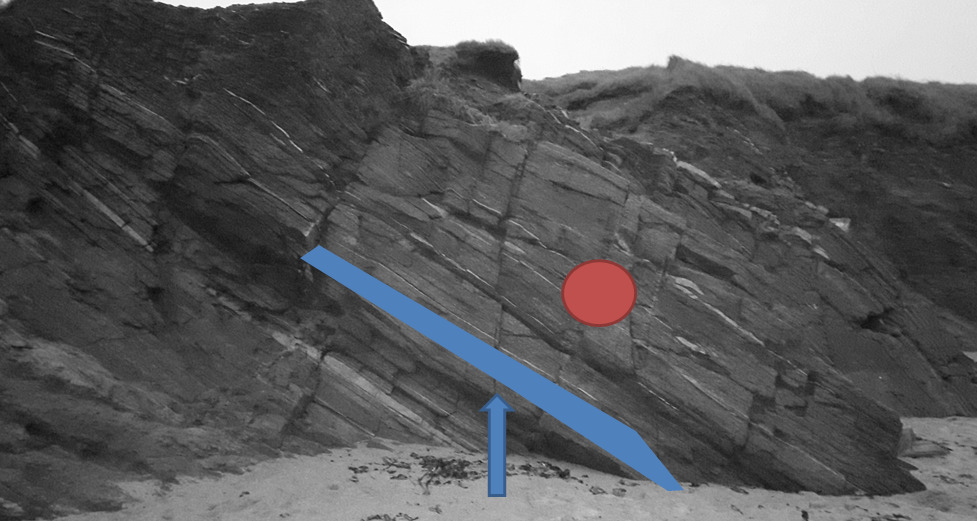
- Question 1 : Décrivez la roche du WP1 (couleur, litage, taille des grains, déformation) et déduisez-en sa nature. Quel est son protholithe ?
- Question 1: Describe the rock of WP1 (color, bedding, grain size, deformation) and deduce its nature. What is its protholith?
- Question 2 : Que voyez-vous sous la zone rouge ? Quelle est sa nature ?
- Question 2 : What do you see under the red zone? What is its nature ?
- Question 3 : Estimez le rejet du cisaillement visible au niveau de la flèche de la zone bleue.
- Question 3 : Estimate the rejection of the visible shear at the level of the arrow in the blue zone.
Point 2 : N 48° 20.810 W 004° 46.215
Poursuivez vers le WP2 (photo WP2).
Continue to WP2 (photo WP2).

- Question 4 : Décrivez la roche (couleur, litage, taille des grains, déformation) et déduisez-en sa nature. Quel est son protholithe ?
- Question 4 : Describe the rock (color, bedding, grain size, deformation) and deduce its nature. What is its protholith?
Vous pouvez vous loguer sans attendre notre confirmation,
mais vous devez nous envoyer les réponses par mail en même temps via notre profil (
fafahakkai).
S'il y a des problèmes avec vos réponses nous vous en ferons part.
Les logs enregistrés sans réponses seront supprimés.Une photo de vous ou de votre GPS à un des WPs (mais sans prendre en photo le panneau ou les spots d'observation) serait la bienvenue, mais n'est pas obligatoire
You can log this cache without waiting for our confirmation, but you must send us the answers by e-mail at the same time via our profile (fafahakkai).
If there is a problem with your answers we will notify you. The logs recorded without answers will be deleted.
A picture of you or your GPS to a WPs (but not to photograph the sign or observation spots) would be welcome but is not mandatory.
Rappel concernant les « Earthcaches »: Il n'y a pas de conteneur à rechercher ni de logbook à renseigner. Il suffit de se rendre sur les lieux, de répondre aux questions ci-dessus et de nous renvoyer les réponses.
Reminder concerning "Earthcaches": there is neither a container to look for nor a logbook to sign. One need only go to the location, answer to the differents quiestions and send us the answers.